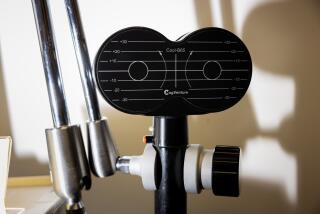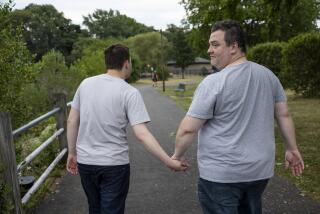A Closer Look at the Birds and the Bees
- Share via
Magnetic resonance imaging, or MRI, which normally offers images of patients’ brains, spinal columns and joints, has now been used by Dutch researchers to view human genitalia during sexual intercourse.
Such efforts to learn more about the physiology of the act have a long history. Researchers William H. Masters and Virginia E. Johnson wired subjects with electrodes decades ago to study the effects of arousal. More recently, American researchers have been examining MRI as a way to provide an objective measure of female arousal during studies of drugs like Viagra that might promote female responsiveness.
The University Hospital Groningen team, however, is the first to publish attempts to capture the sex organs during intercourse. The current study was reported in Saturday’s British Medical Journal.
The small size of the MRI machine’s opening presented an obvious problem. Dr. Willibrord Weijmar Schultz and his colleagues were forced to recruit subjects who were shorter and thinner than average, but the opening of the imager still had to be widened slightly. The eight participating couples also were asked to remain motionless for 15 seconds while the imaging was performed.
Nonetheless, the team successfully imaged the sexual organs and found that, during female arousal, the uterus rises and the anterior (front) vaginal wall lengthens. But there was no evidence of an increase in the volume of the uterus, as had been reported by Masters and Johnson.
The Dutch researchers also found that during intercourse in the missionary position, the entire penis (both the external organ and the internal root) is neither straight nor “S” shaped as had been previously thought but is, in fact, the shape of a boomerang.
In perhaps the least surprising conclusion, considering the ambience, the team found that the men had more problems with sexual performance--specifically, maintaining an erection--than did women. Women were able to perform, but those who had orgasms labeled them “superficial.”
The Secret Agent’s Antioxidant of Choice
“Bond . . . James Bond” is the most popular line from the well-known series of movies, but close behind is “a martini, shaken, not stirred.” Bond never explains his preference, but a Times colleague and martini aficionado notes that a stirred martini is usually more diluted by the ice and is not as cold. Also, a stirred martini is clear, while a shaken one is cloudy.
But there could be medical differences as well. Canadian researchers have reported that a shaken martini is a better antioxidant than a stirred one, a discovery that could help explain Bond’s apparent good health. Antioxidants, such as vitamins C and E, are thought to help protect against heart disease and cancer, among other conditions, and may also protect against aging.
Biochemist J.R. Trevithick and his colleagues at the University of Western Ontario used a routine assay to measure the capacity of martinis (two parts gin, one part vermouth) to destroy hydrogen peroxide, a standard measure of antioxidant ability. They report in Saturday’s British Medical Journal that a stirred martini was better than either gin or vermouth alone at destroying hydrogen peroxide, but that a shaken martini was nearly twice as effective as a stirred one. They have not yet been able to determine why, they noted, nor have they studied any potential contribution of olives.
The Risks of Unsafe Sax
Every year, the British Medical Journal saves some of its most unusual submissions, including the two previously mentioned, and publishes them in its Christmas issue. These are real papers, although some researchers’ motivations might be considered questionable.
A third report in Saturday’s edition examines the dangers of “unsafe sax.” Dr. Sanjay Kinra of the National Health Service and Dr. Mona Okasha of the University of Bristol studied the mortality of 813 jazz musicians born between 1882 and 1974 and concluded that those who played wind instruments had twice the risk of premature death as did vocalists. Brass players were close behind.
The researchers attributed the higher mortality rate to the risks of circular breathing, the process in which wind musicians inhale through the nose while inflating the mouth and cheeks in order to produce seamless air streams. This process is stressful and has been linked to strokes and other cerebrovascular accidents. Playing other instruments--or being a bandleader--was found to lower the risk.
Study Lauds Heart Arrhythmia Implants
Implantable defibrillators are much better than drugs for treating people with abnormal heart rhythms, such as presidential candidate Bill Bradley, a new study shows. Drugs attempt to prevent arrhythmia, while implantable defibrillators sense it and apply a small shock to restore the heartbeat to normal.
Dr. Alfred Buxton of Brown University and his colleagues studied 704 arrhythmia patients, giving half drugs and half defibrillators. They reported in Thursday’s New England Journal of Medicine that there were 76% fewer heart attacks among those receiving the defibrillators. The devices have been implanted in about 100,000 Americans, but an estimated 1 million could benefit from them.
Brain Devices May Combat Depression
An implanted brain pacemaker used for treating epilepsy can also help severely depressed patients, according to a small study released Wednesday on the Internet. Researchers at the University of Texas Southwestern Medical Center at Dallas implanted the device, called a vagal nerve stimulator, in 30 patients.
They reported in the online version of Biological Psychiatry that 40% of the patients showed substantial improvement after the implant. The researchers cautioned that further studies are needed because the number of patients was so small. An estimated 18 million Americans suffer from depression, and about 1 million of them are resistant to conventional drug treatments.
*
Medical writer Thomas H. Maugh II can be reached at thomas.maugh@latimes.com.





